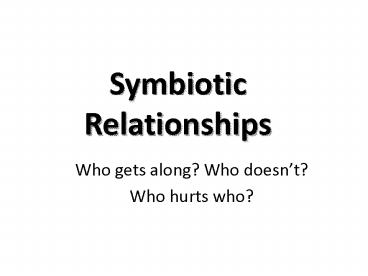Symbiotic Relationships - PowerPoint PPT Presentation
Title:
Symbiotic Relationships
Description:
Symbiotic Relationships Who gets along? Who doesn t? Who hurts who? Hermit crab anemone - mutualistic * Tick on dog - parasitic * parasites * Tomhornworm ... – PowerPoint PPT presentation
Number of Views:181
Avg rating:3.0/5.0
Title: Symbiotic Relationships
1
Symbiotic Relationships
- Who gets along? Who doesnt?
- Who hurts who?
2
Species Interactions
- 5 basic types of interactions of species within
an ecosystem. - Interspecific competition When members of two
or more species interact to gain access to the
same limited resources. - ie food, light, space
- Predation when a member or group of members of
one species feeds directly on another species. - Usually animal to animal
- Rare cases of plants to animal
- Parasitism when one species feeds on/in the
body of another species and harms it. - Mutualism interaction of two species when both
benefit from the interaction. - Commensalism interaction of two species when
only one benefits from the interaction and the
other is not harmed or benefited.
3
Species Interactions
- Interactions have a significant effect on the
resources used and the population of different
species within the ecosystem. - b/c of these interactions the ability to
reproduce and or survive is influenced. - Natural selection takes place through
interactions. - The most common interaction is competition.
- For limited resources
- Requires one species to have the ability to be
more efficient than another when finding and
utilizing resources like food and shelter. - The role species play in an ecosystem is
considered their ecological niche. (ie the job
they have, how they act towards their
environment, what they do in their environment) - When species compete for food, shelter, light
their niches overlap. The more overlap the more
intense the competition.
4
Species Interactions
- Predation (predatory-prey interaction)
- Most consumer species feed off of other consumer
species. - Herbivores feed off of plants and other
producer type species. - Omnivores feed on plants and other living
consumers. - Carnivore feed on other living consumers only
- To survive predators must eat other prey, without
they would die and the evolution of the species
can be stunted.
5
Species Interactions
- Predator/Prey cont.
- Predators a closer look
- Methods used to capture prey
- Herbivores simply walk, swim or fly to the
plant when needing to eat. - Carnivores/Omnivores have moving prey so there
are a few main types of capture to eat. - 1. Pursuit run, chase prey until they wear them
out or catch up to capture and eat. - Usually a single predator after a single prey.
- 2. Ambush When one or more predators lay in
wait or similar techniques to capture and eat
prey - Hunting is an organized way to ambush prey, seen
from lions, wolves, humans, pack type organisms. - Camouflage The predator disguises themselves to
ambush the prey. - 3. Chemical Warfare Predators use venom or
poison to attack prey - Venomous snakes and spiders spit on or bite a
prey organism and wait for them to immobilize
before eating them.
6
Species Interactions
- Prey A closer look
- Evolved/Adapted to avoid predators
- Being able to move fast, quick reflexes (long
legs, strong muscles) - Highly developed sense of sight, smell or hearing
(large eyes, ears, nose) - Avoidance adaptations like shells (turtles),
thick bark (giant sequoia), spines (porcupines),
and thorns (rose bushes, cacti) - Camouflage being able to blend into their
environment so as not to be easily seen. (the
moth, chameleons, cuttlefish) - Chemical Warfare discourage predators to eat
them - by having a Warning Coloration bright colored
markings like red, orange, yellow, blue all with
usually black markings. (some frogs, snakes,
salamanders) - This lets the predator know that they are
poisonous or taste bad and should not be eaten.
(oleander, monarch butterfly)
7
Species Interactions
- Prey cont.
- Foul smelling, gives off a nasty odor when
startled or caught (skunks, skunk cabbage,
stinkbugs) - Irritating gives off a chemical or needles that
irritate the predator. (bombardier beetle,
stinging nettles) - Mimicry acting like or looking like an organism
that is poisonous so as not to be eaten (viceroy
butterfly looks like the monarch) - Living in large groups so as to not to be the one
most likely eaten (schools of fish tuna
Zebras) - Usually the one captured and eaten are the sick,
old or young of the group.
8
Symbiosis
- Three types of Symbiotic relationships between
organisms - Mutualism both organisms benefit from the
interaction. - Commensalism One organism benefits, the other
organism is not harmed or benefits from the
interaction. - Parasitism One organism benefits, the other
organism is harmed, but may not always die during
the interaction.
9
Looking at pics
10
(No Transcript)
11
(No Transcript)
12
(No Transcript)
13
(No Transcript)
14
(No Transcript)
15
(No Transcript)
16
(No Transcript)
17
(No Transcript)
18
(No Transcript)
19
(No Transcript)
20
(No Transcript)
21
(No Transcript)
22
(No Transcript)
23
(No Transcript)

